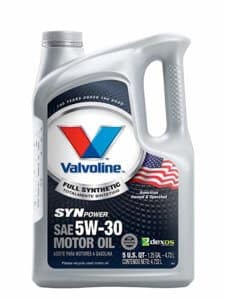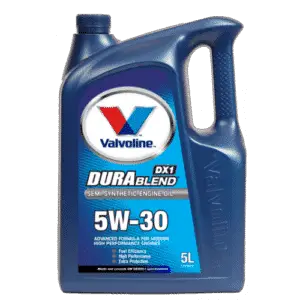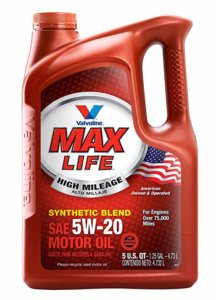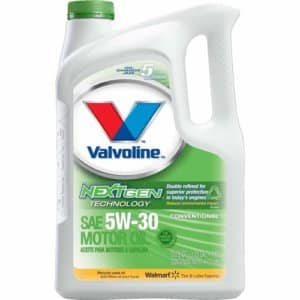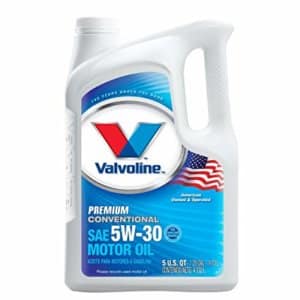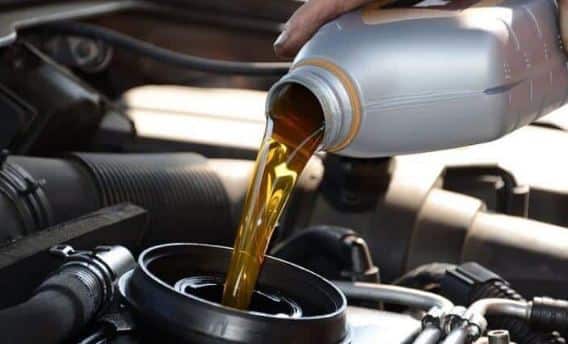
Table of Contents
Should you use a special motor oil for hot weather? Is there really a difference between summer motor oil and winter motor oil for your car or truck?
Well, first of all the type of oil that you use should first depend on your vehicle’s manufacturer specifications, how much you drive your vehicle and where you drive your vehicle.
However, seasons and climate can also play an important role in the type of motor oil that you should use to achieve optimal results.
This is especially true for the summer months and hot weather. So, let’s take a look at which motor oil will help you keep your engine healthy and performing at optimal during the summer months.
Top 5 Best Motor Oils For Hot Weather

Best Motor Oil For Hot Weather summer
1. Best Overall
Designed to protect your engine in extreme temperatures, the Valvoline SYNPower is a fully synthetic motor oil ideal for severe driving conditions.
As such, it’s exactly the kind of oil you can confidently use in your high-end sports car or work pickup truck that’s exposed to extreme driving conditions daily with sky-high mileage annually.
Being a fully synthetic formulation, it guarantees maximum lubrication and overall engine protection at a very affordable price.
Additionally, you don’t have to worry about mixing it with other additives like most options available on the market today.
Here are a few more reasons why it’s worth your money:
| Pros | Cons |
|---|---|
| Outstanding high- and cold-temperature protection | May not be ideal for vintage vehicles |
| Fast oil flow during startup | |
| Excellent engine cleanliness | |
| Superior varnish protection |
Verdict
The Valvoline SYNPower full Synthetic formulation gives you superior engine protection by addressing three major engine issues: heat, wear and deposits.
That’s because the oil is formulated with durable anti-wear additives that last long in the oil. The price is also very hard to resist.
2. Best For Highway Conditions
The Valvoline DURABlend is a mixture of traditional mineral motor oil with synthetic motor oils. The oil is well-blended to give your engine the many advantages of using synthetic oil at a reduced price point.
Additionally, you can go back to using regular oil whenever you want, unlike when you choose to go with a full synthetic formulation.
Unlike the conventional motor oil, the Valvoline DuraBlend gives you an extended life-time of up to 5000 miles on city conditions before changing it.
You can also do up to 6000 miles on highway conditions while getting better fuel mileage. Moreover, it reduces the engine’s wear and tear in extreme conditions better than leading conventional motor oils.
| Pros | Cons |
|---|---|
| Increased protection in tough driving conditions | Not ideal for high-end sports cars |
| Advanced additive technology | |
| Better fuel mileage | |
| Easy to go back to conventional products |
Verdict
If you want to get better fuel mileage without going full synthetic, the Valvoline DURABlend is the motor oil for your engine.
This unique blend of conventional base oils and premium synthetics outperforms leading conventional formulations and provides increased protection in tough driving conditions.
3. Best Value
Just like the DURABlend, the Valvoline MaxLife High Mileage oil is a synthetic blend. However, the MAXLife is very impressive due to its high level of protection and performance in high-mileage engines. As such, its an excellent choice for vehicles clocking more than 70,000 miles on the odometer.
The Valvoline MaxLife is formulated with anti-wear additives, special seal conditioners and extra detergent technology.
It also comes with a wide array of antioxidants that boost the long-term health of your engine. This proprietary formula also reduces sludge, oil leaks and poor engine performance in high-mileage cars. Moreover, it comes at an enticingly low price point.
| Pros | Cons |
|---|---|
| Excellent performance in high-mileage cars | Not ideal for low-mileage vehicles |
| Helps to prevent sludge and oil leaks | |
| Bargain price | |
| The extra detergents keep the engine clean |
Verdict
The Valvoline MaxLife is a bargain-priced semi-synthetic motor oil that delivers maximum protection for your high-mileage vehicle.
On average, the oil change interval is anywhere between 5,000 and 7,000 miles. That’s shorter than most full synthetic brands, but that’s to be expected from a blend. Nonetheless, its performance is worth every penny.
4. Best Environmental Friendly
With everyone jumping on the green bandwagon today, recycled oil is proving to be the best option for the environmentally-conscious vehicle owners.
The Valvoline NextGen is the best in this class, offering up to a 150,000-mile guarantee. It cuts the use of crude products to lower emissions and reduce the impact on the environment compared to oils without recycled products.
The Nextgen is triple filtered to eliminate all the micro-impurities in the oil and the refined again to bring it at the right chemical properties.
Additionally, it exceeds the industry’s demanding API specifications for viscosity, wear and sludge protection.
| Pros | Cons |
|---|---|
| Low emissions and environmentally friendly | Not ideal for modern hybrid vehicles |
| Triple-filtered to remove impurities | |
| Excellent functionality | |
| Great sludge and wear protection |
Verdict
If you’re trying to use environmentally conscious products around your home, the Valvoline NextGen is the ideal oil for your car.
The oil offers the same performance as leading conventional oils while cutting down the emissions and the use of crude products. It also exceeds the high standard API specifications for both wear and sludge protection.
5. Best For Old Engines
When working with an old engine, synthetic oils may not work very well. However, the Valvoline Premium Conventional oils work well with most old engines to protect against various types of deposits.
The oil works well in different temperatures and it helps to keep your engine cleaner than most mono-grade oils.
Being a premium conventional product, the oil comes with durable anti-wear additives to enhance its protection and offer improved oxidation control.
It also delivers thorough anti-wear protection that exceeds the current European, Japanese and US wear tests.
| Pros | Cons |
|---|---|
| Enhanced oxidation control | Not ideal for high-demanding engines like trucks or sports cars |
| Protects against all deposits | |
| Thorough anti-wear protection | |
| Resists oil thickening like a boss | |
| Competitive price |
Verdict
If you’re running an old car, the Valvoline Premium convention is the best option for you. It’s among the cheapest brand on the market, but its hold up very well in different temperature levels. Its also very slippery and good quality compared to other conventional oils sold in the US.
Heavier Weight Oil In Hot Weather and Summer Months?
When it comes to engine maintenance, some gearheads applaud using a lighter-weight oil in vehicles during the winter and heavier-weight oil in the summer.
But is there any benefit or pitfall to using lighter-weight oils in the winter and heavier-weight oils during the summer? Some of the older car owners swear it’s vital for proper maintenance.
Do You Need Oil To Keep The Engine Healthy
Compared to other aspects of car maintenance, oil is subject to a lot of controversies, misinformation, myths, and outdated information.
Of course, it’s essential to use the right oil to keep the engine healthy, but most people don’t understand what that means.
In the past, changing oil weight in the winter or summer months used to be a vital part of proper engine maintenance. That’s because conventional oil formulations only had a single viscosity, and the oil would get thin when heated.
That would cause starting problems in the winter months because the oil would be converted to molasses, making it hard for the pumps to lube the engine properly.
To avoid such issues, lightweight oil like a 10-weight was used during the cold weather to allow it to flow easily.
Heavier 30 or 40-weight oils would be used during the summer to ensure the oil doesn’t break down due to the heat. However, this problem has since been solved by multi-viscosity oil.
This oil thickens to protect the engine when it’s hot and flows better than single-grade oils during the summer, making it the best in all seasons.
Multi-Viscosity Oil Explained
Also known as a multi-grade oil, multi-viscosity oils are essential for maintaining the longevity of modern car engines.
That’s because the oil is capable of offering the best protection in both hot and cold weather conditions.
For this reason, most modern engines use multi-grade oils which are easy to identify as they have an oil grade labeled along the lines of 10W40, with “W” indicating winter.

Multi Viscosity Oil for hot weather
For instance, multi-grade oils such as 10W40 indicate that the oil has two viscosity grades – one similar to a 10-weight in cold temperatures to minus 30 c. The oil also protects like a 40-weight in extremely hot conditions reaching up to 100 c.
This oil performance innovation means that you don’t need to change weights for the season as it may be detrimental to your car’s engine.
Multi-viscosity oils are highly efficient in all temperature ranges, and modern engines are designed to work specifically with this type of oil as listed in the owner’s manual.
Older car models can also use these modern oils too, but you’ll need to base the first viscosity to match the current climate.
For example, 0W is ideal for northern Canada, while 10W will be great for Florida. Additionally, you need to use the original oil specification for the operating weight, though most older cars will work fine with 10W30.
While speaking of oil, it’s worth demystifying synthetic oil to help you understand what’s best for your car.
Demystifying Synthetic Oils
You’ve probably heard gear-nerds praising the superiority of synthetic oil or even seen some of your friends using it.
Synthetics are just natural oil refined at a much higher degree using complex additives to improve performance in extreme conditions.
As such, this type of oil is common with new high-performance vehicles and sports cars. It’s actually mandatory for some of these vehicles according to the user manual.
As earlier mentioned, you should stick to the manufacturers recommended oil for the best performance and longevity of your car’s engine.
However, if you’re planning to push your car’s engine to the extreme by towing or constantly stopping and moving, synthetic oil may be what you need to protect your vehicle in the long term.
But are synthetics better than multi-viscosity oils for your vehicle?
Why Choose Synthetics Over Conventional Engine Oils
To avoid breakdowns and mechanic visits, proper care and maintenance of your vehicle’s engine are crucial. It’s also essential to prolong the lifespan of your engine parts and minimizing the replacement cost.

Synthetic vs Conventional Engine Oils hot weather
For that, proper lubrication system and oil are among the sure ways to ensure your engine runs efficiently to save fuel consumption and maintenance costs.
Compared to multi-viscosity oils, synthetics clearly offer superior performance in extreme temperatures where flammability and high loads are overriding factors.
They perform well in complex applications like in racing cars, meeting targeted performance benchmarks without overheating issues.
Here’s why you should consider synthetics over conventional oils:
Reduced Risk Of Oxidation
Unlike conventional engine oils refined from crude oils, synthetics are engineered in controlled environments to produce a product that’s uniformly consistent and superior. That translates into a greater life cycle for your engine parts.
The purity of the synthetic oils and the strong bonds developed between the molecules also means less risk of oxidation compared to any other type of engine oil.
With less risk of oxidation, synthetics can perform better than conventional oils, which contain a lot of impurities that cause oxidation in high temperatures. The impurities also break down the oil’s integrity, requiring the car owner to change the oil frequently.
Improved Viscosity
In extremely low temperatures, conventional oils also get compromised easily due to the presence of paraffin.
The paraffin reduces the oil’s fluidity, causing great wear and tear when starting the engine after a very long cold night. That’s because the engine oil settles at the bottom, creating less lubrication for the engine’s moving parts.
Since conventional oils are normally less fluid when exposed to extremely cold temperatures, it takes longer for the oil to circulate in the engine, leading to a significant amount of damage on the parts.
However, synthetic oils perform better as they maintain their viscosity all temperature levels, helping to prevent the wear and tear caused by cold engine startups.
Efficiency
In an engine, the improved viscosity of synthetics translates to greater efficiency compared to conventional oils.
That’s because the oil remains fluid at extreme temperatures, both high and low. That translates to lower running costs and less frequent oil changes.

Viscosity synthetic vs conventional oil hot weather
At a time when the world is more conscious about environmental pollution than ever, the purity of synthetic oil also reduces harmful gas emissions. That’s why most low emission cars use synthetics.
Additionally, it reduces the risk of the engine catching fire in extremely high temperatures owing to poor lubrication of the engine parts.
That gives synthetic oils a distinct advantage over conventional solutions which can ignite easily, thus improving the driver’s safety.
Tips To Maximize Hot Weather Motor Oil Performance
Depending on the vehicle manufacturer’s specifications, where you drive and the amount of stress you put on your car, synthetic oil may not be for you.
However, that doesn’t mean that you can’t maximize the performance of your car’s conventional motor oil.
Here are several tips to keep your vehicle’s engine healthy during the summer.
1. Use Multi-Viscosity Oil
The issue of choosing and changing the vehicle engine oil depending on the temperature was solved when the automotive industry shifted from straight-weight oils to multi-viscosity oil.
This change occurred over a decade ago, though some older vehicle models still use single-grade oils as specified in the car owner’s manual.
With new car models, you should always follow the oil specifications indicated on the user’s manual to avoid any temperature issues. That’s because the engineered that built the engine have already tested it to know what works best.

Multi Viscosity Oil hot weather
As earlier mentioned, multi-viscosity oils in one rate in cold weather and another when warmed to operating temperatures.
For instance, a 5W30 oil acts like a 5-weight lubricant during the winter and thick 30-weight oil when it’s warm. That means you don’t need to switch the oil back and forth with the season changes.
If you’re still using an antique vehicle that uses single-viscosity engine oil, you may need to use a thicker oil for areas experiencing high temperatures in the summer. Nonetheless, it’s well worth the switch to multi-viscosity oil.
2. Go Synthetic
Thanks to lower levels of impurities compared to standard engine oil, Synthetic oil handles stress like a boss.
It also uses unique additives and detergents to protect the engine against the stress caused by high RPMs during the hot summer season.

Synthetic motor oil
Aside from handling the stress caused by high temperatures, synthetics are also highly capable of resisting the thinning and foaming that occurs at these temperature levels.
It’s no wonder more EOMs are increasingly specifying synthetic oil for daily driving due to high pressures, close tolerances and high pressures created by most modern vehicle engines.
In some cases, if you plan to head to the race tracks or towing services regularly, switching to full synthetic formulations will be the best summer oil choice you can make.
3. Change The Oil Regularly
Does your summer driving routine include off-road trails, gravel tracks, or dirt road? If your answer is yes, you’ll need to change the oil and filter regularly than recommended by the manufacturer during this hot season.
The oil filter does it best to eliminate small particles from your vehicle’s grime, but fine dust can still make its way through.
As a result, you need to maintain a highly aggressive oil change interval to maintain the highest protection levels when cruising on dusty roads regularly.
When determining the oil change schedule, you’ll need to be honest about your driving routines. It might shock you to know that your boring commute habits actually put your vehicle in the severe-duty service schedule.
That means your car might need an oil change more often than normal.
Checking Your Motor Oil
Checking your car’s oil is a simple task that needs to be done at least once every three months or before going on a long road trip.
For this, your car needs to be parked on level ground to ensure that it doesn’t alter the results.

Check motor oil
You’ll also need to do this when the engine is cold to avoid burning off your fingers unless the manufacturer recommends having it hot. Here’s what you need to do:
- Start by opening the bonnet to locate the dipstick, which should be easily visible.
- Pull out the dipstick from the engine and start cleaning the oil from the end.
- Once clean, put back the dipstick back and remove it again to analyze both sides. That helps you to check the oil level depending on the dipstick measurement. The indicator will be anywhere between L to H (min to max).
- If the car is out of oil, buy the best multi-viscosity or synthetic oil and add it to the engine. However, if the oil is at the right level, check its color, and ensure there are no metal particles in it. The right color should be black or brown.
- If there are metal particles, you may need to see a mechanic as it usually indicates internal engine damage.
How To Change Your Motor Oil
Unlike other vehicle maintenance procedures like cleaning the exhaust system, changing your motor oil is relatively easy.
Start by finding the recommended type of oil as indicated in the owner’s handbook. Once you have it at hand, locate the filler cap, usually marked with an oil icon on the lid and open it to add the oil.

Changing motor oil
However, you should avoid overfilling the engine as it can damage it. As such, you need to pour the oil in the engine in small amounts while checking the dip regularly.
Place a funnel at the top of oil sprout and pour in the oil gently. Use the dipstick to ensure that the oil is on the correct level after pouring each half a quart to avoid overfilling the tank.
However, if you note that you’re regularly topping up the oil, you should check for a leak or check whether your vehicle is burning oil.
Recap
To keep your car running on hot weather, keep an eye on the oil levels, use synthetics when necessary, and don’t prolong oil changes.
It’s also a good idea to check the owner’s manual to know the best type of oil for your engine.
 by
by 